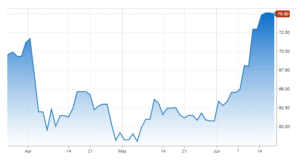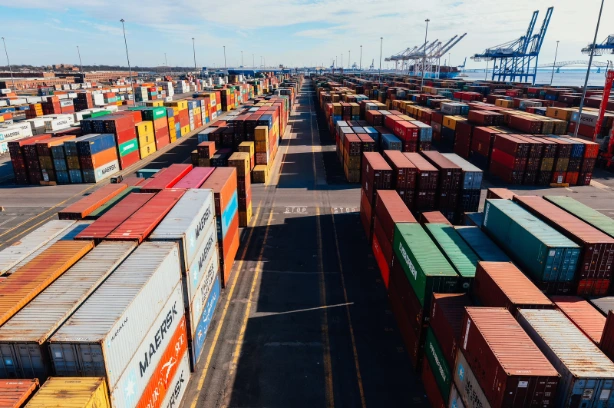By Preserve Gold Research
Fear is tightening its grip on the American public as global tensions continue to escalate. A possible World War III, an economy on the brink—once seemingly distant threats now feel immediate, even inevitable, for some. Flashpoints across the world have grown as intense as they are frequent, leaving many to wonder if this marks the beginning of something far more dangerous unraveling. In a 2024 survey, over half of Americans said they feared the U.S. could be pulled into another world war. A nearly equal number worried they wouldn’t have enough money to survive in the future. To sociologist Christopher Bader of Chapman University, the takeaway is alarming: “Americans are becoming more afraid, in general, about everything.” War and financial insecurity have moved to the center of the nation’s anxiety. And those fears are proving justified.
The Middle East Teeters After Israel’s Massive Air Assault
Just days before Israel shocked the Middle East with a massive air assault on Iranian targets, a senior U.S. diplomat warned that global risk levels were “more serious than any other time in the past.” The warning came on the heels of a string of escalating tensions between the two countries over Iran’s nuclear program and its support for militant groups in the region.
On the morning of January 13, these tensions reached a boiling point when Israel launched Operation Rising Lion, a sweeping military campaign that shattered traditional red lines and reignited fears of a wider conflict. In one night, over 200 Israeli jets struck more than 100 targets across Iran, including nuclear enrichment sites, missile depots, Revolutionary Guard bases, and even non-nuclear military infrastructure. Specially planted Mossad munitions inside Iran targeted air defenses and radar arrays, giving Israel near-complete control of Iranian skies.
The fallout has been swift and fierce. Iranian media reports at least 224 killed, including nuclear scientists and senior military commanders. Tehran retaliated with missile barrages and drone attacks that struck Israeli cities and military sites, raising concerns the conflict could spiral. While Israel presses on, claiming it has rolled back Iran’s nuclear program, analysts warn the strikes may simply accelerate Tehran’s ambition rather than halt it. But what transforms this from regional warfare into something with global consequences is the rapid alignment of international forces around both Israel and Iran.
On Israel’s side, a coalition of Western democracies has lined up. The U.S. has openly provided intelligence, missile defenses, and political cover, though it has stopped short of direct military action. Britain, France, Germany, Australia, Japan, and even parts of NATO have emphasized Israel’s right to self-defense, claiming that Iran’s nuclear program poses a threat not just to Israel but to regional and global stability. “Iran is the principal source of regional instability and terror,” G7 leaders said in a joint statement released just days after the attack. “We affirm that Israel has a right to defend itself,” they added.
On the other side, Iran is rallying its own axis of resistance. Tehran is deepening ties with Russia, China, and North Korea—countries already coordinating to challenge the U.S.-led global system. Putin publicly condemned the Israeli strikes as “unprovoked and unacceptable,” a response delivered even as Russia continues to rely on Iranian drones in Ukraine. China, which depends on Middle Eastern oil and treasures its strategic pact with Iran, has also called for restraint while warning of serious consequences if the conflict expands. Iran itself has threatened to close the Strait of Hormuz, a move that experts say could cripple global oil markets and draw direct U.S. naval intervention.
The Eastern Front Heats Up After Covert Ukrainian Attacks
As war rages in the Middle East, Europe’s own deadly conflict has taken a darker turn. Now entering its third year, the war in Ukraine has become a brutal war of attrition. Yet recent events have revealed that the conflict is far from contained. In early June 2025, Ukraine executed a covert operation that caught military analysts off guard and sent tremors through the Kremlin. In a mission code-named Spiderweb, Ukraine’s Security Service (SBU) launched a coordinated drone assault on several of Russia’s most critical airbases. Using modified long-range drones that sneaked deep into Russia and even launched from inside Russian borders, the Ukrainians struck two of the crown jewels of Moscow’s air power: strategic bomber bases hundreds of miles from Ukraine.
The news shocked the world. In a single, well-coordinated attack, Ukrainian drones struck deep into Russian territory, damaging or destroying over 40 Russian military planes in one night. The scorched hulks of Tu-95 bombers, capable of carrying nuclear-capable cruise missiles, were left smoldering on the tarmac as a clear message to Moscow that Ukraine was not backing down. Condemning the strikes as “acts of state terrorism,” Russian President Vladimir Putin promised retaliation. Within days, Moscow launched one of its heaviest aerial bombardments of Ukraine in months, something that it openly framed as retribution for Spiderweb.
Internationally, the Ukraine war’s escalation has only deepened great power rifts. Western officials quietly applauded the raid, viewing it as a bold strike against Russian aggression. But behind closed doors, there’s a growing sense of unease. By hitting targets so deep in Russia, Kyiv has crossed a threshold that Washington had long quietly discouraged out of fear it could trigger a dangerous Russian backlash. Reports suggest that Ukraine did not inform the U.S. in advance about Operation Spiderweb, likely because Washington might have vetoed such a risky mission.
The Trump administration now faces a precarious balancing act. It continues to affirm Ukraine’s right to defend its sovereignty, but it must also contain the risk of escalation that could drag NATO into direct conflict with Russia. Following Ukraine’s Spiderweb operation, Moscow’s top officials issued new nuclear-tainted warnings, repeating that Russia would use “all available means” to protect itself if attacked. These words have stirred long-dormant anxieties in Western capitals, conjuring fears of nuclear escalation even on a remote frontier. The threat of nuclear retaliation, however unlikely, looms larger as the Kremlin signals that its red lines may be closer than anyone assumed.
The Most Dangerous Moment in Decades?
In January 2025, the Bulletin of the Atomic Scientists moved the symbolic Doomsday Clock to just 89 seconds to midnight, the direst setting in its history, citing “escalating global security risks, including war [and] nuclear threats.” United Nations Secretary-General António Guterres echoed this alarm previously, warning that “humanity is just one misunderstanding, one miscalculation away from nuclear annihilation.”
We now face a world that has grown organized into informal power blocs, with the U.S. and its allies on one front and an anti-Western axis of Russia, Iran, China, and North Korea on the other. Although not yet a declared world war, the patterns of alliance, the entrenchment of proxy and diplomatic networks, and the retreat from multilateral institutions suggest that we are already in a new Cold War.
“This is a dangerous situation,” warned François Savary, chief investment officer at a Swiss wealth management firm, as markets shuddered at the latest war news. “This is one of those situations where everything is under control, and then everything is not under control.” Within a span of weeks, a major war in Europe has escalated, and a new war in the Middle East has ignited, all against the backdrop of existing tensions in East Asia and other regions.
For many, the current geopolitical climate evokes the darkest days of the 20th century. In Europe, Russian aggression and NATO’s eastward resolve have created the tensest standoff with Moscow since the Cuban Missile Crisis of 1962. In the Middle East, longstanding enmities (Israel versus Iran) and newer conflicts (the aftermath of the Israel-Hamas war of 2023) are converging. In Asia, relations between China and the U.S. remain fraught. Chinese warplanes and ships probe Taiwan’s defenses regularly, while Washington has committed to Taiwan’s defense if Beijing ever attempts an invasion. Meanwhile, North Korea continues to test missiles and nuclear devices, reminding the world that another flashpoint is simmering on the Korean peninsula.
What makes this moment particularly dangerous is the growing risk of chain reactions. Conflicts are no longer isolated by geography, as they were in the past. The interconnectedness of our world means that a crisis in one region can quickly spread to others, often with little warning. Russia’s war in Ukraine, for instance, has had direct spillover effects: It hardened Western public opinion against military aggression and arguably emboldened Israel to believe that decisive force might be tolerated in a separate context.
Iran, seeing Russia face minimal Western intervention in Ukraine (beyond sanctions and arms deliveries), may have calculated that it could push ahead with nuclear enrichment; Israel, seeing the West’s focus divided, chose to strike before Iran could get any closer to a bomb. With Israeli and Iranian forces now trading blows, the United States is once again being pulled deeper into Middle Eastern security commitments. Experts say this could serve the interests of Russia and China, who stand to benefit from Washington being overstretched and distracted.
Public sentiment has mirrored the rising sense of danger felt by many in the region. In a poll conducted in May 2025, most citizens across Western nations said they believed a third world war was likely within the next 5-10 years. And this was before the war in Ukraine escalated and before Israel’s strike on Iran. Across Europe and North America, large majorities also expect that any World War III scenario would involve nuclear weapons and result in catastrophic casualties far beyond those of World War II.
While world leaders are aware of the stakes, diplomatic efforts have struggled to keep pace with the fast-moving crises. Big-power vetoes have paralyzed the United Nations Security Council as countries increasingly negotiate complex alliances and security agreements outside traditional multilateral frameworks. “We are watching and worried,” said one U.S. diplomat of the current global risks.
But unlike the Cold War, when nuclear-armed superpowers maintained back-channel hotlines, today’s geopolitical landscape is fractured. Conventional deterrence is breaking down, and nuclear taboos are under pressure. Analysts note that Iran’s Supreme Leader has hinted at contingency plans involving asymmetric responses if threatened. Russian officials have echoed similar language, warning that they will use “all means” to defend their interests.
Every additional strike, every public denunciation, every defensive deployment tightens the spiral of violence. The real question is how far this trajectory can go before it breaks into open global conflict. Will lawmakers in Washington or leaders in Beijing pull back before escalation crosses the nuclear threshold? Or will this dynamic push us into the worst kind of collision, where regional wars suddenly link into a broader conflagration?
Everyday Goods Could Soon Get Pricier
Beyond the immediate military and diplomatic consequences, the unfolding conflicts cast a long shadow over the global economy and, by extension, the American economy. War has always been a harbinger of economic turbulence, and today’s conflicts are no exception. In the wake of Israel’s airstrikes on Iran, markets reacted violently. Oil prices surged more than 7% in a single day, the sharpest jump in over three years, as fears mounted that a broader war could threaten exports from the energy-rich Persian Gulf. Brent crude briefly spiked more than 10%, brushing against $75 per barrel before settling closer to $73 with a 5.7% gain.

WTI crude prices surged to $74.83 per barrel by mid-June, marking the steepest rally in over a year as geopolitical tensions in the Middle East reignited fears of supply disruptions. Source: CNBC
Analysts have already begun outlining darker scenarios. If Iran retaliates by shutting down the Strait of Hormuz, a narrow maritime corridor responsible for a third of the world’s oil traffic, prices could soar to $130 a barrel or higher. “Any oil supply shock would have global implications,” noted Matt Gertken, a geopolitical strategist, who foresaw nearly even odds of the conflict escalating to the point where the U.S. is drawn in and oil prices double.
For American consumers, these numbers hit the wallet directly. A spike in oil prices means higher gasoline and diesel costs, which in turn drive up prices for goods across the board. Just as inflation in the U.S. has begun to cool, a Middle East crisis now threatens to send a new wave of rising prices washing over the economy. Mohamed El-Erian, chief economic adviser at Allianz, warned that surging energy costs could create a “stagflationary shock,” the toxic combination of stagnant growth and high inflation. “The average consumer,” El-Erian explained, will face “more income uncertainty” and higher prices at the pump. In other words, Americans may soon find their paychecks stretched even thinner, with little to show for it.
With the U.S. economy teetering through a fragile post-pandemic recovery while nursing stubborn inflation, any new shocks threaten to derail the hard-won progress made so far. If the United States becomes further involved—say, by ramping up military aid or deployments —federal spending will shift even more toward defense. While arms manufacturers might hire more workers (a silver lining for certain industries), the classic guns-versus-butter trade-off could mean less investment in domestic priorities like infrastructure, education, or healthcare.
Then, there is the Fed’s dilemma to contend with. Increased government spending and borrowing to meet wartime needs often put upward pressure on interest rates. While the Fed has been contemplating interest rate cuts to stimulate economic growth, it might have to reverse course in the face of rising inflation.
In simpler terms, American households could soon feel the conflict in their daily lives. Heating and electricity bills may climb this coming winter if global natural gas supplies tighten or prices spike due to instability. The cost of groceries might rise if key commodities (wheat, cooking oil, fertilizers) become scarcer. Ukraine and Russia are major exporters of grains and inputs, and a protracted war or further sanctions can constrain supply. Big-ticket purchases, from cars to homes, could become more challenging if consumer confidence dips or interest rates remain high. All of this comes at a time when many families are still regaining their financial footing after the shocks of the past few years.
Gold Surges as Investors Brace for Escalation
Today, the world is grappling with a convergence of crises that few of us could have imagined just a few years ago. Two simultaneous flashpoints now dominate the headlines, reviving a specter the world hasn’t faced in generations: a true global war. What seemed like fringe alarmism has made its way to mainstream conversation as tensions between major world powers continue to rise.
For households anxious about where to park cash in an era of growing global risk, many financial experts are pointing to gold as a strategic safeguard. “Gold has been breaking out to the upside since last year, and the price momentum still has a ways to go,” noted Henry Yoshida, CEO of Rocket Dollar. “There is the foundational makeup of an upside gold price super cycle that could raise the price of gold beyond current levels.”
The yellow metal has a long track record as a hedge in times of crisis and 2025 is proving no exception. In the hours after Israel’s June 13 strikes on Iran, prices sprinted past $3,430 an ounce and, by June 16, briefly touched $3,451, just shy of April’s all-time high. Analysts predict that any further escalation, especially a disruption to oil flows through the Strait of Hormuz, could push gold prices even higher. In such a scenario, investors may rush to gold not only as a haven but as a hedge against oil-driven inflation and the broader threat of stagflation.








